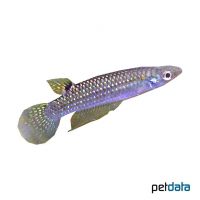Green Panchax (Aplocheilus blockii)
| Green Panchax Aplocheilus blockii | |
|---|---|
| Name | Green Panchax |
| Name Lat. | Aplocheilus blockii |
| Family | Killifishes |
| Family lat. | Aplocheilidae |
| Order | Killifishes & Livebearers |
| Order lat. | Cyprinodontiformes |
| Origin | South Asia |
| Habitat | Streams, ponds |
| Diet | Carnivore |
| pH | 6.5-7.5 |
| Behavior | ♂ territorial |
| Keeping | Pair, harem |
| Care Level | Moderate |
| Reproduction | Substrate spawner |
| Breeding | Moderately difficult |
| Life Span | 3-5 years |
| Protection | No |
| Metric Units | |
| Size | 4-6 cm |
| Temperature | 20-28 °C |
| Hardness | 5-12 °dH |
| Aquarium | 80 l |
| US Units | |
| Size | 1.6"-2.4" |
| Temperature | 68-82 °F |
| Hardness | 89-214 ppm |
| Aquarium | 25 gal |
Distribution and habitat
The range of the Madras pike is southern India (Madras) and Sri Lanka. They live in shallow, stagnant or slow-flowing waters, such as ponds, rice paddies and streams with dense vegetation, where these lurkers prefer to stay among aquatic plants or under dense overhanging riparian vegetation.
Maintenance
The aquarium should have a dense border planting, with hiding and retreat possibilities (roots) and offer sufficient swimming space. A dark substrate covered with some foliage (e.g. sea almond leaves) and slightly dimmed light (floating plants) allow their colors to come out particularly well
No ammonia, ammonium and nitrite should be detectable, the nitrate value should not exceed 100 mg/l. To ensure the water quality and oxygen content, a filter and heater adapted to the aquarium size is required, as well as lighting for the species-appropriate day-night rhythm of the animals.
Diet
The diet consists of live food, such as cyclops, daphnia, artemia and red mosquito larvae, which is also well accepted freeze-dried or frozen, supplemented with commercially available frozen special food mixtures. Occasionally, high-quality, high-protein dry food (flakes, granules, micropellets) is also accepted. It is recommended to feed small portions several times a day, which are eaten within a few minutes. A regular and varied diet promotes health and prevents deficiency symptoms.
Behaviour and compatibility
They should be kept in pairs or better in a harem, one male with several females. Males are very territorial within the species, so keeping several pairs or harems is only recommended in a larger and richly structured tank. They can be socialized well with other fish, although fish that are too small are considered food.
Basically, only compatible fish species with similar demands on water condition and water temperature should be socialized.
Sex dimorphism
The males are larger and more colorful than the females.
Reproduction and breeding
They are plant spawners, preferring to spawn their hard-shelled eggs with adhesive filaments on fine-feathered plants. No brood care is practiced. The fry hatch after 10-15 days depending on temperature
Fry must be fed several times a day with special rearing food (Artemia nauplii, microworms, dust food). In a community tank breeding is hardly possible, because the spawn is easy prey.
Important
These non-annual killifish live in waters that hold water year-round.
They like to jump, so the aquarium should be well covered. The foliage (sea almond tree, oak, etc.) enriches the water with humic substances, naturally lowers the pH and when rotting promotes the development of microorganisms, which are a valuable secondary food source.
The well-being of the fish should be monitored regularly. Temperature should be checked daily, pH, hardness and nitrate levels at least every 14 days. Regular partial water changes are recommended, even when contaminant levels have not yet reached the upper limit. Sudden changes in water quality should be avoided. Newly introduced fish must be accustomed slowly to the water in the aquarium.
Further literature can be found in your pet store.
References
Text: petdata; Image: petdata
Source: BMELV (1998): Tierschutzgutachten - Haltung von Zierfischen (Süßwasser); RIEHL & BAENSCH RIEHL (2006): Aquarien Atlas Bd. 1, Mergus Verlag; ENGELMANN (2005): Zootierhaltung - Tiere in menschlicher Obhut: Fische, Verlag Harri Deutsch
- Gemäß § 21 Abs. 5 Tierschutzgesetz idgF
